Category: Air National Guard
F-16 mission may be coming to Gowen starting in 2027
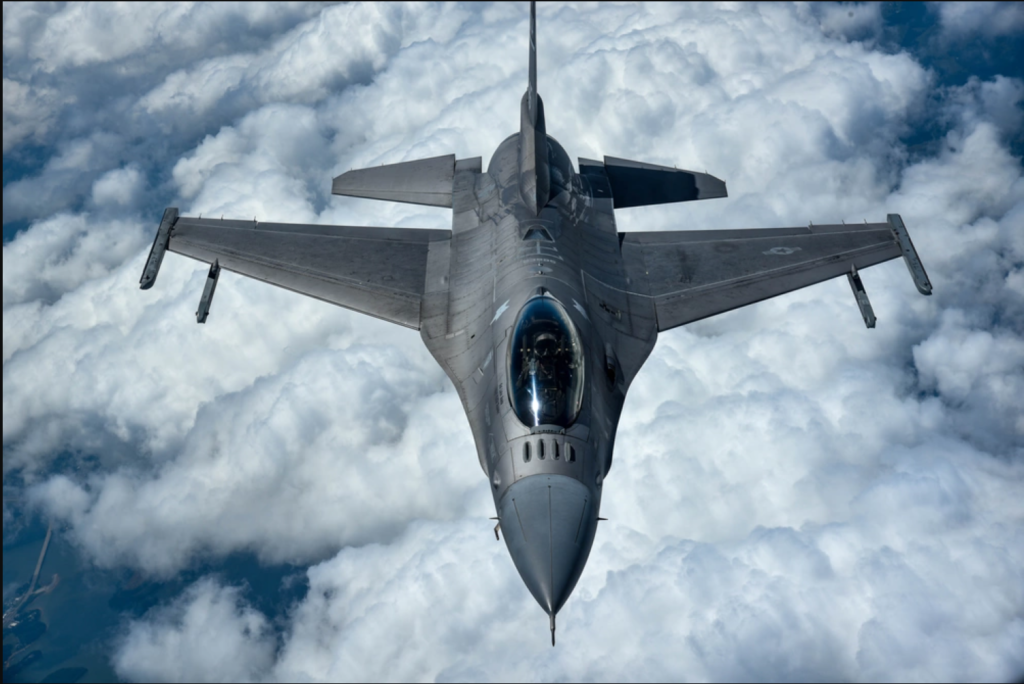
Photo by Tech. Sgt. Teri Eicher , 134th Air Refueling Wing
Gov. Brad Little and members of Idaho’s congressional delegation are proud to announce that the U.S. Air Force has identified the Idaho Air National Guard’s 124th Fighter Wing to potentially receive an F-16 Fighting Falcon mission at Gowen Field in Boise, Idaho.
F-16s are expected to begin arriving at Gowen Field in 2027.
“Idaho is proud of the critical role we have long played in supporting the nation’s defense strategy through the valuable work of the men and women serving at Gowen Field,” Gov. Little said. “The transition to the sophisticated F-16 mission at Gowen Field is the next step in the Idaho Air National Guard’s enduring commitment to safeguarding the liberties and freedoms we hold dear as Americans. This is an exciting step that will benefit the State of Idaho and the United States of America.”
The Idaho Air National Guard has maintained a fighter mission at Gowen Field for more than 75 years. This transition would replace the 18 A-10 Thunderbolt IIs that have been in service at Gowen Field since 1996. The one-for-one exchange would include the same number of F-16s, which are a more advanced and combat-effective aircraft.
The Air Force has planned to divest its aging A-10 inventory for more than a decade. Discussions have been ongoing among Idaho National Guard leaders, and local, state, and federal officials since 2012. Then, the Idaho Air National Guard was notified that their A-10 fleet was identified for divestment by 2015. However, events in Southwest Asia at the time extended the aircraft’s relevance just as the 124th FW embarked on the largest deployment in its history the following year. The 124th FW deployed again in 2020 marking its second largest deployment.
This modernization will better align the Air Force to support the current National Defense Strategy by leveraging the 124th FW’s existing fighter aircraft operations and maintenance expertise once the A-10s at Gowen Field are retired, beginning in the fall of 2026.
“Deterrence is a critical aspect of the National Defense Strategy,” said Brig. Gen. Tim Donnellan, commander of the Idaho Air National Guard. “Today’s near-peer adversaries like Russia and China remind us it’s imperative to ensure our personnel are trained and proficient with the best equipment and tools necessary to fight and win our nation’s wars.”
The Idaho National Guard expects a more detailed timeline from the Air Force in the coming months that will outline the next steps, such as the completion of an environmental impact analysis, planned for the spring of 2025.
The Idaho Air National Guard has been a fixture of the community since 1946. Since then, Idaho National Guard pilots have transitioned through 9 different types of fighter aircraft. With each new aircraft, the organization modifies its noise abatement procedures to minimize the impacts of jet noise on the community.
“Idaho National Guardsmen are rooted in every community in the state,” said Maj. Gen. Michael Garshak, adjutant general of Idaho. “When we are called upon, it’s your friends, families and neighbors coming together to support our community and our nation. Being good stewards of our environment is a priority and we will ensure Boise continues to be one of the most livable cities in the country, regardless of the aircraft we operate.”
Monday’s announcement from the Secretary of the Air Force would mean the continued viability of the Idaho National Guard. With more than $650 million dollars in annual economic impact coupled with nearly 8,000 jobs the Idaho National Guard creates, securing a follow-on fighter mission is a critical part of ensuring Idaho’s prosperity.
German soldiers train with Idaho Air National Guard A-10 pilots
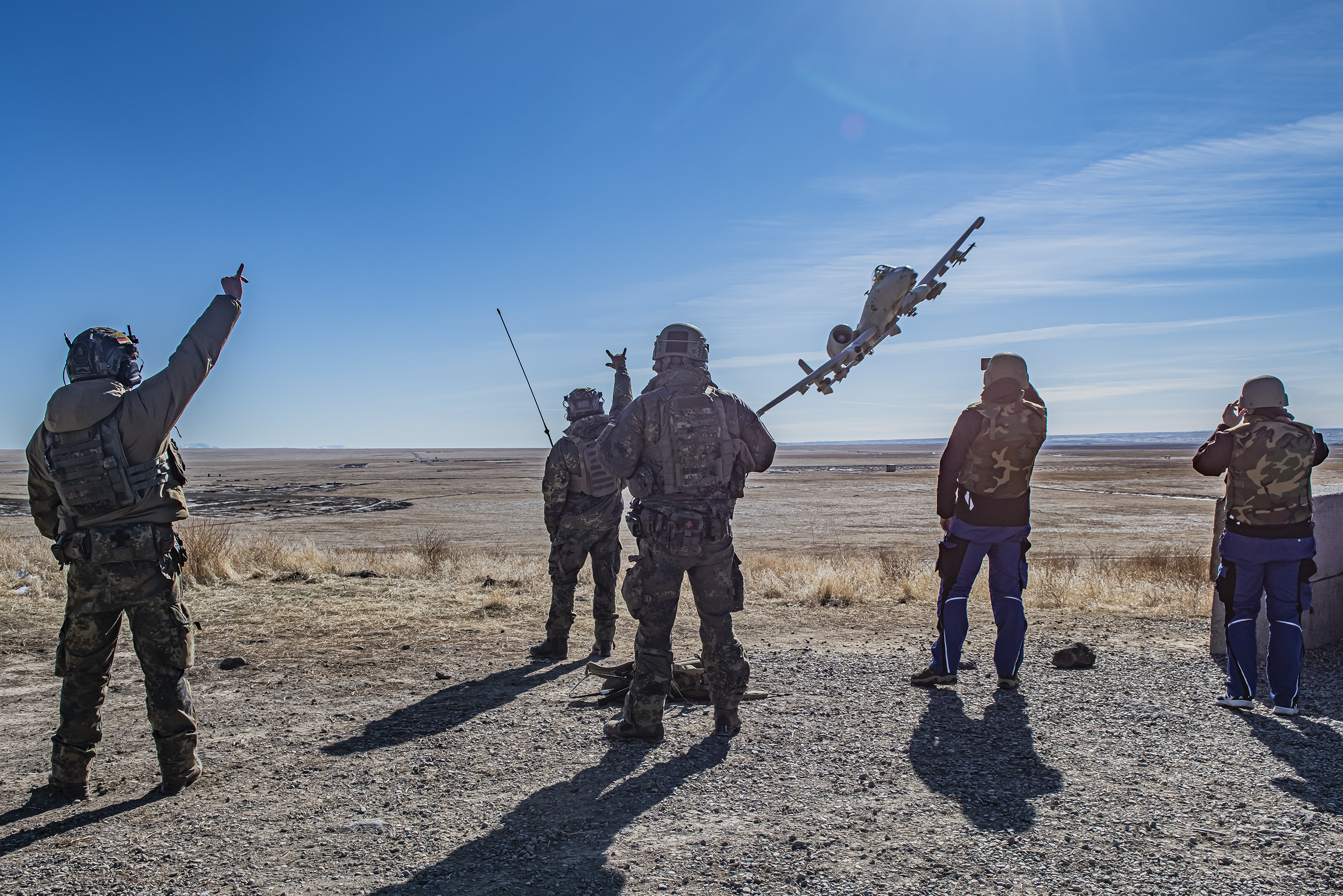
Soldiers from the German Army’s 6th Battery of the Artillery Battalion 345 joined forces with A-10 Thunderbolt II pilots assigned to the 124th Fighter Wing’s 190th Fighter Squadron Feb. 11 to 22, to conduct close air support training at Saylor Creek Range, Idaho.
“The 190th Fighter Squadron supports and encourages this training so we are prepared and familiar with our NATO counterpart’s tactics, techniques, and procedures,” said Lt. Col. Mike “Jack” Hampton, 190th Fighter Squadron commander. “The training also enables us to establish lasting relationships that we can rely on during times of war.”
The visiting soldiers from Idar-Oberstein, Germany, consisted of joint terminal attack controllers, who coordinate, integrate and direct the actions of combat aircraft engaging in close air support operations, and joint fire observers, who augment JTACs by relaying target data. The unit has trained in Idaho annually since 2016.
“The 190th accepts us here, dedicates training to us and improves our tactical training,” said a JTAC instructor from the German Army. “They honor our unit, and I am very proud in the trust that they set in us.”
The joint training between the Idaho Air National Guard and German forces incorporated NATO TTPs utilizing A-10 aircraft to prosecute targets ranging from armor, artillery, bunkers, revetments, aircraft, simulated enemy combatants, moving targets, surface to air threats and more.
“All of these target sets are incorporated into one training range, which delivers unmatched training compared to anywhere else in the world,” said Hampton. “Each training mission is complex and detailed to mirror any future conflicts in or around the European Theater but can also be used in any region of the world.”
Located approximately 43 miles southeast of Gowen Field, Saylor Creek Range offers an impact area three miles wide by six miles long, where air and ground assets can employ live munitions. A joint fires platoon sergeant with the German Army said the training site is unlike anything they have in Germany.
“In Germany, our soldiers never get into realistic situations like they do in Idaho because of training restrictions,” said the platoon sergeant. “Here you can be 500 meters away while a 2,000-pound bomb is flying off the jet. It helps our soldiers to see live munitions hit their targets because then they know what they say to pilots really matters.”
On the range, the German soldiers rehearsed various training scenarios to refine their procedures while both forces worked to hone their joint communication.
Later this year, members of the 124th Fighter Wing will deploy to Germany in support of Air Defender 2023.
One team, one fight: Army and Air join forces for mass casualty, medevac training
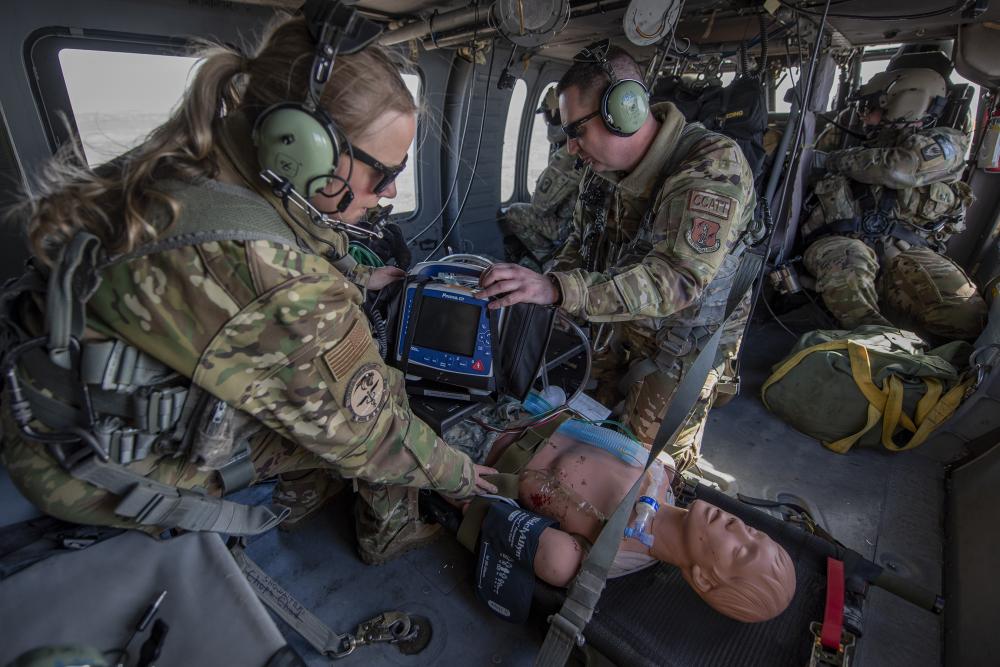
Idaho National Guard Soldiers and Airmen, as well as active duty counterparts joined forces with a one-team, one-fight mentality for joint training during a mass casualty exercise on Feb. 4 near Gowen Field.
“The best way to grow our mindset of becoming more operational and ready for a deployed environment is to train with the nearby resources, such as the Idaho Army National Guard and our active duty counterparts,” said Senior Master Sgt. Virginia Holmgren, a respiratory therapist from the Idaho Air National Guard’s 124th Medical Group. “Forming relationships with the other branches helps us to become familiar with each other’s capabilities and to practice working together because when we are in a deployed environment we will be working with the other branches in the fight.”
Medical personnel from Gowen Field’s 124th Medical Group and active duty medical personnel with the 366th Medical Group from Mountain Home Air Force Base teamed up for several mass casualty events, which also included the use of medevac Soldiers and UH-60 Black Hawk helicopters from the Idaho Army National Guard’s 1st of the 168th Aviation Regiment to participate in the medical evacuation scenarios.
“This exercise is a great example of how the Idaho National Guard is committed to the joint warfighting doctrine in support of the National Defense Strategy,” said Brig. Gen. Tim Donnellan, Idaho Air National Guard commander. “The 124th Medical Group coordinated this incredible training using combat proven units from the Idaho Army National Guard, the Idaho Air National Guard, and the Gunfighters of the 366th Fighter Wing.”
During the scenarios, combat medics performed treatment and stabilized casualties at a field medical tent in a simulated deployed location. The focus for the combat medics during the mass casualty scenarios was an emphasis on Tactical Combat Casualty Care. The TCCC is the military guideline for trauma life support in pre-hospital combat medicine, designed to reduce preventable deaths while continuing to maintain operation success.
“With our new DoD guidelines for the TCCC, it requires us to have more hands-on deck and for more Airmen to be familiar with trauma care in responding to worse injuries out on the field rather than the typical self aid and buddy care that we have focused on in the past,” said Senior Master Sgt. Davis Nguyen, the 124th Medical Group Function Area Manager.
Once medics respond and stabilize casualties, they could then recognize the patients that needed more advanced critical care at a hospital outside of the combat field location and the 9-Line medevac call requesting the Black Hawk medevac team was made. In combat, the 9-Line is an emergency medevac request with an accurate report of combat injuries that is often the difference between life and death.
The ground combat medics and the Black Hawk flight medics worked together to stabilize the casualty during flight until they reached the simulated higher echelon of medical care.
Additional scenarios required protective gear to be worn during a chemical, biological, radiological or nuclear event while Idaho National Guard Soldiers conducted hoist rescue training, allowing Airmen the chance to gain insight into a full range of rescue capabilities of the medevac Soldiers.
“I am proud of the commitment of the men and women in this joint, total force exercise demonstrating the incredible talent and the first class training capabilities we have here in Idaho,” said Donnellan. “We will continue to maintain our readiness for the immediate fight while preparing for any conflicts of the future.”
A small Idaho town makes a big Veteran’s Day impression
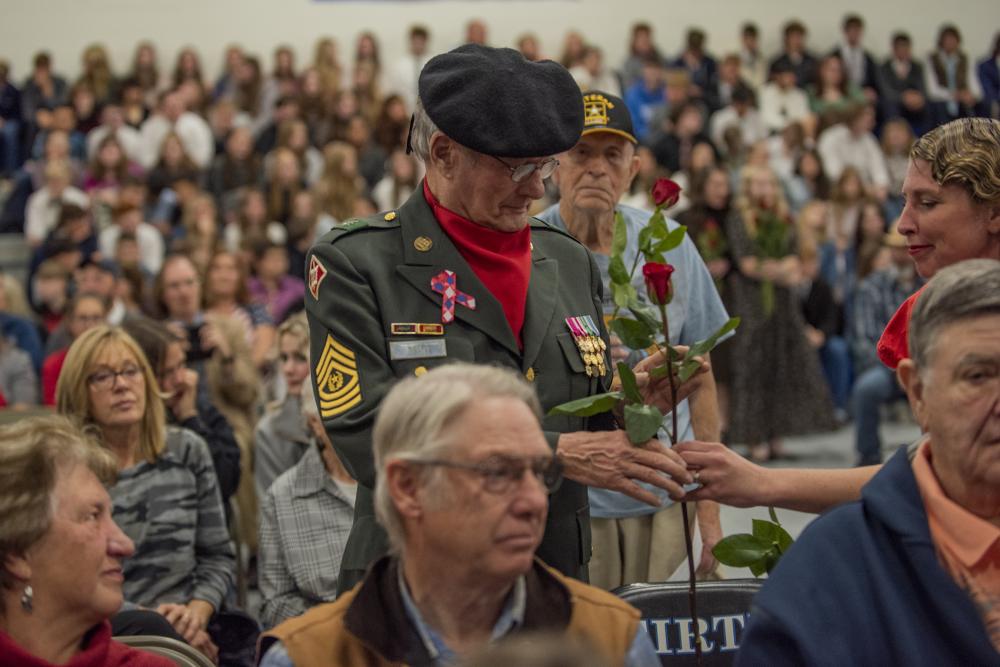
The rural town of Firth held a large Veteran’s Day assembly in Eastern Idaho on Nov. 10th, inviting hundreds of attendees, including Idaho’s adjutant general, Maj. Gen. Michael Garshak.
The assembly honored more than 100 local veterans and their families with help from more than 600 local and surrounding town volunteers, students, teachers and administrators. The assembly was held at Firth High School. The population of the small town is just shy of 600 people, according to the latest United States Census Bureau.
Four Soldiers from the Idaho National Guard’s 148th Field Artillery Regiment posted the flags. Local veterans of all branches and current service members were recognized at the assembly and presented with plaques and roses. Garshak spoke at the assembly about the importance of patriotism.
“Those of us in the military in Idaho are fortunate to serve in a state that truly honors and appreciates military service, and nowhere more so than here in Eastern Idaho,” said Garshak.
He continued. “While Veteran’s Day is an opportunity to thank those who have sacrificed, especially during times of war, where the survival of our nation has hung in the balance, it is also an opportunity to recognize and appreciate the value military service brings to our state, our country and to those who serve.”
Garshak thanked every veteran, past and present, and future veterans, for their service to our nation. He thanked the crowd for their support as well on behalf of the Idaho National Guard and the U.S. military.
Garshak closed his remarks with the takeaway that military service is not all about sacrifice.
“Yes, there are times when it is hard, but that comes with all walks of life,” he said. “I’ve learned that the things we value the most, and bring the greatest reward, are the things that we have worked the hardest for.”
Boise firefighters train Idaho’s Civil Support Team on rope rescue
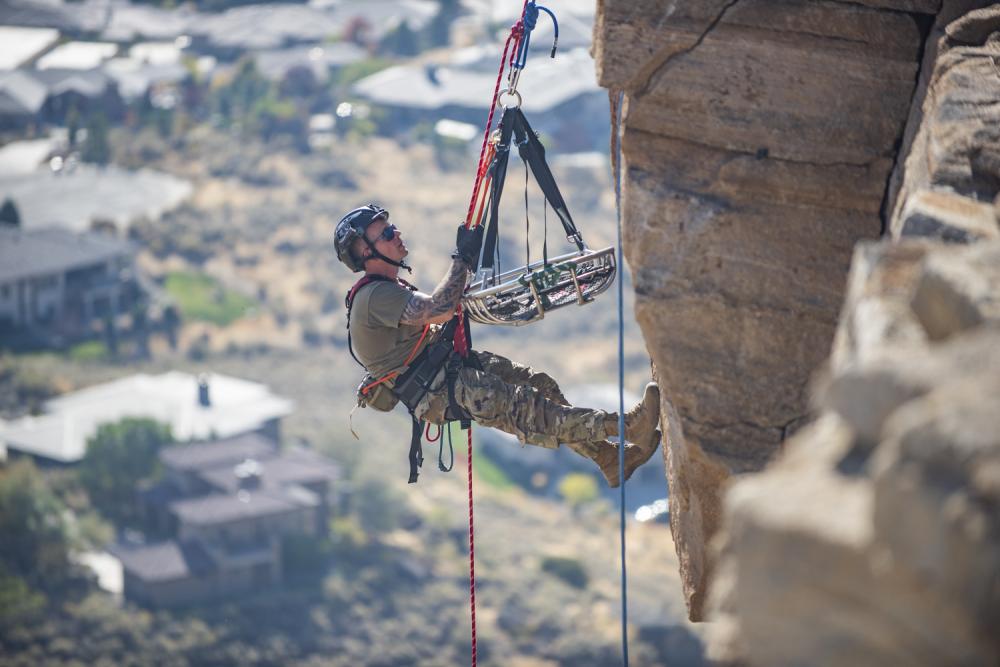
Throughout the month of October, the Idaho National Guard’s 101st Civil Support Team partnered with the Boise Fire Department Technical Rescue Team to participate in a ropes rescue course taught by Boise firefighters. The course, which served as an annual recertification for the CST Guardsmen, entailed two weeklong sessions for the 22-member team and helped the Boise firefighters refine their skills as trainers.
“This training benefits both the Idaho National Guard and us,” said Brent Matthews, captain of the Boise Technical Rescue Team. “Not only are we certifying our partners on ropes rescue training, but our instructors also get valuable experience and more proficient as certifiable instructors.”
The first week, Oct. 10th through the 14th, started with the classroom portion of learning about ropes rescue as a prerequisite for the hands-on portion of the training. Using what they learned about the ropes, the CST Guardsmen rappelled from tops of buildings at the Boise Fire Department’s Fire Training Center.
Once the Guardsmen were proficient at ropes rappelling, they practiced ropes rescues using wire rescue baskets at cliffs near the Table Rock trails in the Boise foothills to simulate a large-scale rescue of multiple people.
“To utilize the CST in ropes rescue, there would be an instance where something serious happened like a natural or man-made disaster or an emergency where the local search and rescue team wouldn’t have enough resources and could call us,” said Lt. Col. Robert Grimes, 101st CST commander.
The second weeklong training, Oct. 24th through 28th, focused on confined space rescues at Boise’s Lucky Peak Power Plant. The training mirrored a scenario where a devastated occurrence or a large-scaled catastrophe, like an earthquake, happened with severe damage to a building that could involve chemicals. This would require HAZMAT precautions, along with a large number of rescues in buildings with confined spaces, and would involve ropes and sked stretchers.
These incidents could be intensified by a lack of oxygen that is available in a non-ventilated area and complicated by the tight confines of the space, requiring rescuers to have air tanks during a rescue.
“Confined space is a rescue of people, for instance, inside of a building, in a tunnel or inside tanks where there could be a HAZMAT situation. They might be injured too badly to get out on their own or they could be unconscious,” said Grimes. “The CST has the capability to respond to weapons of mass destruction and HAZMAT scenarios already. The ropes rescue and confined space training adds another capability for the CST to assist the local fire departments and local agencies.”
The Boise Fire Department Technical Rescue Team is highly trained to handle the emergencies involving ropes rescues and confined space rescues, however, they could call upon their 101st CST partners if the large number of rescues surpassed their limit.
“We’ve been building this relationship and working together for quite a while,” said Matthews. “The CST has really great HAZMAT capabilities. Having the CST already trained at HAZMAT, plus the ropes rescue and confined space training, benefits us as well. In the future, I’d like to see us integrate more in real-world situations. When we have a HAZMAT call with confined spaces, we can call them to assist. I can see us working really closely together in the future.”
Leveling up: Female Soldiers, Airmen serve in leadership positions across the Idaho National Guard
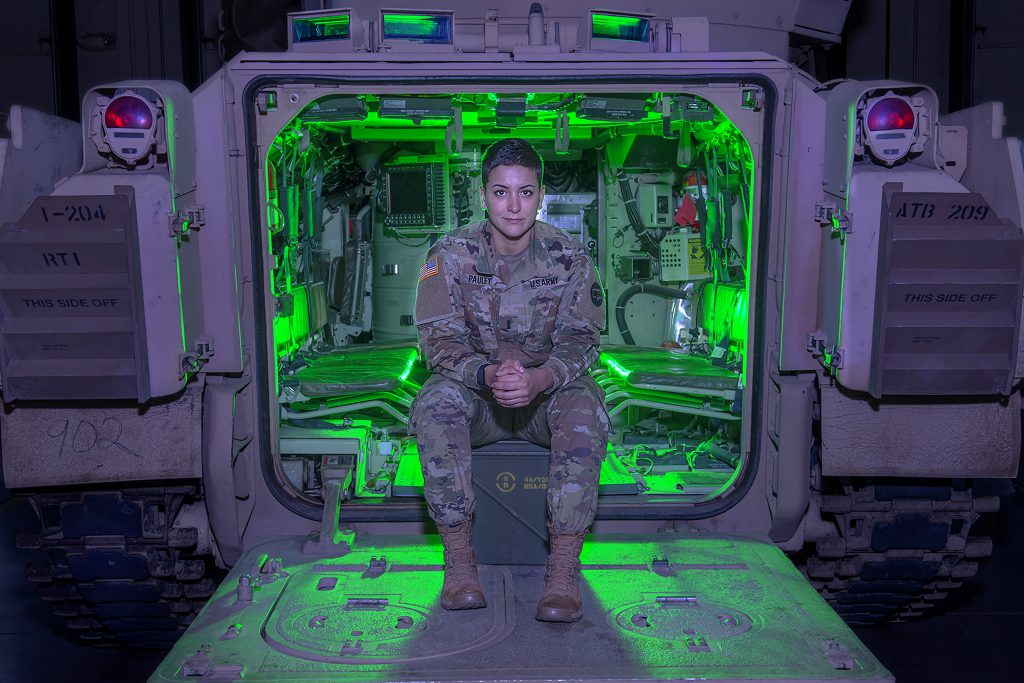
Maj. Robert Taylor/Idaho Military Division Public Affairs
Betty Corn became the first female to serve in the Idaho Air National Guard when she joined as a nurse in 1959. Female members wouldn’t enlist into the National Guard until 1968.
Since then, female citizen-Soldiers and Airmen have continued to blaze their own paths in the Idaho National Guard, even before the Army integrated females into combat-arms in 2015. Over the past decade alone, Idaho National Guardsmen have transitioned into career fields that were not previously opened to them or reached new heights in their profession while continuing to ensure the organization remains “Always Ready, Always There” to respond to emergencies at home or in defense of our national interest throughout the world.
In 2012, then Cpt. Nicole Smith, now Lt. Col. Nicole Washington, led more than a 100 Company A, 1-168th General Support Aviation Battalion Soldiers to Afghanistan for a year-long deployment, becoming the first female officer to lead an Idaho National Guard unit to combat as its senior officer.
In 2013, Chief Master Sgt. Tammy S. Ladley became the first female to serve as the 124th Fighter Wing’s senior enlisted member. The next year, Col. Sherrie McCandless became the first female to command the wing. McCandless now serves as the commanding general of the D.C. National Guard.
Also in 2014, Maj. Kimberly Tschepen became the state’s first female Soldier to command a battalion when she took command of the 145th Brigade Support Battalion and Command Sgt. Maj. Linda Burkhart became the state’s first female command sergeant major in 2015.
In 2015, Idaho Guardsman 1st Sgt. Erin Smith became the nation’s first female enlisted Soldier to graduate from M1 Armor Crewman School. Following her, Staff Sgt. Kylene Huerta completed the same course and became the first female Soldier to be assigned to the 116th Cavalry Brigade Combat Team as a tank crew member. In 2017, Sgt. 1st Class Melanie Galletti graduated from the U.S. Army’s Infantryman Course as the Idaho National Guard’s first qualified female enlisted infantry Soldier.
In 2017, Col. Lora Rainey was appointed as the state’s first female staff judge advocate.
In 2019, 2nd Lt. Brooke Berard and 2nd Lt. Lauren Bolt graduated from the U.S. Army’s Armor Basic Officer Leaders Course as the state’s first two female armor officers and 2nd Lt. Jessica Pauley became the state’s first female infantry officer.
Today, female Soldiers and Airmen proudly serve in leadership positions at every level of the Idaho National Guard, from the team level in the Army Guard to the group level in the Air Guard. In honor of women’s history month, we celebrate not only their accomplishments, but the fact that many of them are still writing their own history within our organization.
Female Soldiers and Airmen are trusted to lead their fellow Guardsmen. Soldiers like Sgt. Kaylee Bloxham, a combat engineer in charge of a Bradley Fighting Vehicle and its crew; and Airman like Chef Master Sgt. Kelly Bongiovi, who now serves as the senior enlisted member of the Idaho Air National Guard after she replaced Ladley as the 124th Fighter Wing’s command chief master sergeant.
On the officer side, 2nd Lt. Jessica Pauley, will lead an infantry platoon of infantry on a deployment later this year and Col. Elizabeth Sumner, the highest-ranking female in the Idaho National Guard, leads more than 340 Airmen as the 124th Mission Support Group commander.
Sgt. Kaylee Bloxham
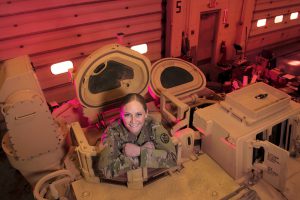 Sgt. Kaylee Bloxham didn’t set out to be the Idaho Army National Guard’s first female 12B combat engineer. It’s a feat she didn’t realize she had accomplished until after she graduated from the required reclassification course.
Sgt. Kaylee Bloxham didn’t set out to be the Idaho Army National Guard’s first female 12B combat engineer. It’s a feat she didn’t realize she had accomplished until after she graduated from the required reclassification course.
She was only looking to serve her country and follow in her older sister’s footsteps when she enlisted into the Idaho Army National Guard in 2006 as a military police Soldier. She reclassed after the 116th Brigade Special Troops Battalion transitioned to the 116th Brigade Engineer Battalion in 2016 and the unit eliminated its MP platoon.
Bloxham chose to become a combat engineer after observing engineers train on C4 demolition during annual training. However, she’s been assigned to a Bradley Fighting Vehicle for the past six years and has yet to complete demolition training herself since reclassing.
“I didn’t like the Bradley at first,” she said. “I didn’t know how it functioned, but now that I’ve been on it for a while and know how it functions, I really like it.”
Bloxham is a vehicle commander in A Company, 116th Brigade Engineer Battalion.
“Not only am I responsible for myself, I’m responsible for two others,” she said.
As a vehicle commander, she is also responsible for a 30-ton armored vehicle equipped with three weapon systems and its gunner and driver. She’s responsible for helping the driver maintain situational awareness in a vehicle with large blind spots and identifying and confirming enemy targets before giving the gunner the command of execution to fire.
“It’s fun,” she said.
She said she loves being able to lead and train her crew as a part-time member of the Idaho National Guard. When she’s not training, she also works as a parts specialist for High Desert Bobcat in Twin Falls.
Staff Sgt. Antonia Lemos
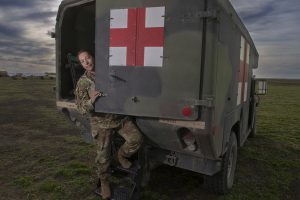 Staff Sgt. Antonia Lemos always knew she wanted to work in the medical profession when she was a kid. She never became a doctor because she didn’t finish college, but by enlisting into the Idaho Army National Guard, she was able to become a 68W combat medic and still have a career in the medical profession.
Staff Sgt. Antonia Lemos always knew she wanted to work in the medical profession when she was a kid. She never became a doctor because she didn’t finish college, but by enlisting into the Idaho Army National Guard, she was able to become a 68W combat medic and still have a career in the medical profession.
“I very much love being a medic,” she said. “As a medic, I am able to do a lot of the things I always wanted to do: help those who are hurt and see interesting wounds.”
Lemos enlisted into the Idaho Army National Guard in 2003. At the time, she was 20 and the single mother of two children. She said she was working fast food and retail and said she didn’t have a lot of direction or self-discipline to finish her education.
“As a single mom, it’s really hard,” she said. “Anything that would benefit my situation for my kids was a good thing and the National Guard looked like an avenue that would provide that, and in the end, it did.”
Lemos liked that she could join the military while raising her kids around her family. She was able to purchase a house by herself using a Veteran Affairs loan. She also found full-time employment as the Idaho Army National Guard’s drug testing coordinator, which interfered with plans to finish college, but she didn’t want to pass up the chance to be able to provide for her family.
Lemos is currently the emergency care sergeant for Headquarters and Headquarters Company, 2-116th Combined Arms Battalion. She was the first female Soldier organically assigned to the battalion when the Army started integrating females into combat-arms units in 2015.
She is a squad leader and assigned as the medic in charge of the battalion’s aid station. As a squad leader, she is in charge of eight Soldiers.
“At this point, I’ve been in long enough where I got to be that young Soldier and now, I’m mentoring young Soldiers,” she said. “Watching Soldiers grow is my favorite part of the job.”
Lemos said she tries to emulate good leadership for her Soldiers, which comes from good mentorship.
“Mentorship comes from above, below and side-to-side, it’s the full 360,” she said.
In addition to watching Soldiers grow, she enjoys being able to assist Soldiers who need additional resources in her role as the Idaho Army National Guard’s drug testing coordinator.
“My favorite part of being an NCO is finding someone who needs help and giving them the resources they need to hopefully be successful, not necessarily in the Guard, but in life,” Lemos said.
Lemos’s father, brother and uncle have also served National Guard.
Sgt. 1st Class Jessica Rice
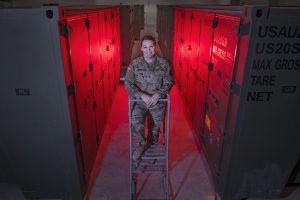 Sgt. 1st Class Jessica Rice has two jobs in the Idaho Army National Guard. During the week, she’s the accountable officer for the 116th Cavalry Brigade Combat Team’s Supply-Support Activity and during drill weekend, she’s a platoon sergeant for A Company, 145th Brigade Support Battalion.
Sgt. 1st Class Jessica Rice has two jobs in the Idaho Army National Guard. During the week, she’s the accountable officer for the 116th Cavalry Brigade Combat Team’s Supply-Support Activity and during drill weekend, she’s a platoon sergeant for A Company, 145th Brigade Support Battalion.
“I love it,” she said. “I’m responsible for training Soldiers. I get to teach them all the things I’ve learned in my 18 years and hopefully make them better than I am.”
As the accountable officer, she supervises seven Soldiers in the epicenter of logistics. The SSA provides a critical link between the brigade’s supply echelons and the national supply chain to ensure rapid fielding of repair parts, which drastically cuts down on the amount of time the brigade’s vehicles are down for maintenance issues.
Rice has supervised the SSA since it was established last year, a position typically held by a warrant officer. Only 11 National Guard states have an SSA.
Rice joined the Idaho Army National Guard after her first semester of college to help pay for her education. She ended up finding full-time employment in the organization before she could finish her degree. She’s been assigned to units in Boise and Burley as well as Lewiston and Post Falls multiple times.
“Throughout my time in the Guard, I’ve had six moves in 10 years,” she said. “Every time I’ve gone to a new unit, I’m instantly family. It doesn’t matter what I’m going through in my life, I have a dozen Soldiers who I could call at they’d be at my doorstep, and it wouldn’t matter why.”
At drill, Rice’s platoon of 22 Soldiers is responsible for distributing the brigade’s Class I (food, rations and water), V (Ammunition) and IX (repair parts) supplies.
As a leader, Rice said communication with her Soldiers is important.
“Make sure what you’re saying is what they are hearing,” she said.
1st Sgt. Lisa Carlin
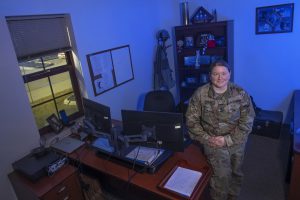 1st Sgt. Lisa Carlin remembers watching “Courage Under Fire” when she was 12 and knowing she wanted to join the military.
1st Sgt. Lisa Carlin remembers watching “Courage Under Fire” when she was 12 and knowing she wanted to join the military.
A few months after graduating high school, she enlisted into the Idaho Army National Guard in 2003 as a 15P aviation operations specialist. Unlike Meg Ryan’s character, she didn’t want to fly because she gets air sick. Aviation operation specialists support aviators from the ground and plan tactical missions.
Nearly two decades later, she is the first sergeant of 1-183rd Assault Helicopter Battalion’s Headquarters and Headquarters Company. As first sergeant, she is responsible for the health and welfare of more than 80 Soldiers.
“It’s all about taking care of Soldiers,” she said. “Regardless of what they have going on, they are the ones doing all the actual heavy lifting. If they aren’t getting taking care of, nothing else will get done.”
Carlin said she chose to join the Idaho Army National Guard over the U.S. Army because she wanted to remain close to home and pursue a college education.
“I already had friends and a support system here,” she said. “The idea of sticking around them seemed more appealing than uprooting every three years.”
Not only was Carlin able to remain close to her friends and family, but she has also made new friends over the years who feel like family.
“I like working with the same group of people throughout my career,” she said. “It builds a family mentality. You get to know them outside of work as well and become lifelong friends.”
The Idaho National Guard also gave Carlin the chance to serve with her actual family. Her sister is a security forces supervisor in the 124th Fighter Wing.
Carlin has been a member of the National Guard’s Active Guard/Reserve program since 2004. She’s served in multiple leadership positions in HHC before becoming its first sergeant. Currently, her readiness noncommissioned officer, Sgt. Kaitlyn Nicolosi, and training specialist, Spc. Jordyn Harris, are also female Soldiers entrusted with key company positions.
“Gender doesn’t play a role,” Carlin said. “It’s been my experience whoever does the job best gets the job.”
Chef Master Sgt. Kelly Bongiovi
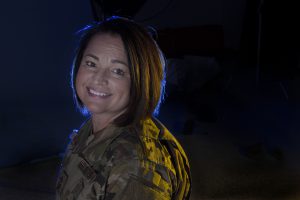 Chief Master Sgt. Kelly Bongiovi enlisted into the Idaho Air National Guard to provide a better life for her family. What she found was a career that has spanned more than three decades and led to her becoming the organization’s senior enlisted leader.
Chief Master Sgt. Kelly Bongiovi enlisted into the Idaho Air National Guard to provide a better life for her family. What she found was a career that has spanned more than three decades and led to her becoming the organization’s senior enlisted leader.
Bongiovi currently serves as the Idaho Air National Guard’s state command chief. By position, she is one of the Idaho National Guard’s most senior enlisted female members and she is the first female Airman to serve as the senior enlisted leader to the commander of the Idaho Air National Guard.
“I never planned on staying in the Air Guard this long,” she said. “I didn’t think they’d want met his long.”
Bongiovi enlisted in August 1991. She spent most of her career working nearly every logistic position in the 124th Fighter Wing before becoming the wing’s command chief in 2018. Over the years, the wing’s mission has changed from flying F-4s to flying A-10 Thunderbolt IIs and C-130s to only the A-10 mission. The logistics squadron’s name has also changed over that time, but Bongiovi’s work ethic has remained consistent.
“I was never in it to make a stripe,” she said. “I was always going to work my hardest and whatever came, came. I figured if I do good things, good things would happen. I just worked really hard and good things happened.”
Bongiovi decided to enlist shortly after tragically losing a child at birth. At the time, she was working in retail and the loss caused her to take a hard look at the life she would have been able to provide her child.
Several of her co-workers were members of the Idaho Air National Guard and told her about the many benefits they received as Guardsmen. Desert Storm was happening around the same time. Another co-worker’s husband deployed in support of the Gulf War but never made it home.
“I knew after I lost my kid, I needed to change my life,” she said. “I just had this passion of what I could do differently in the world to make a difference, not only for myself, but what I could do differently for my family. I also felt very passionate about what was going on in the world. I felt like I needed to join.”
Bongiovi said the biggest change she’s seen over the years is the seriousness of the National Guard’s mission and its increased operations tempo as the Guard became an operational reserve in the aftermath of 9/11. Bongiovi herself has deployed more than a half-dozen times in support of operations around the world.
Bongiovi has no question she was able to build a better life for her family since joining the Air Guard. She credits the support system she found through her fellow Guardsmen and the organization’s vast family resources as reasons why. In addition, she’s worked full time for the Idaho Air National Guard for the past 23 years and met her current husband through her military service.
Her husband, Hal, retired in 2020. He also served as the Idaho Air National Guard’s senior enlisted leader before advancing to the highest enlisted position in the Idaho National Guard as the state’s senior enlisted leader. Their oldest son is currently an A-10 Thunderbolt II crew chief in the 124th Fighter Wing and their youngest son is heavily involved in the organization’s family programs.
“You can pick yourself up when you have to and you can make yourself better,” she said, looking back on the path she’s taken since enlisting 31 years ago.
As the Idaho Air National Guard’s senior enlisted leader, she advises the commander of the Idaho Air National Guard, currently Brig. Gen. Tim Donnellan, on all enlisted matters. She said she doesn’t see the results of her work every single day like she could when she could physically watch A-10s take off and land on the flight line, but that the accomplishments feel much bigger when they do happen, however long they take.
She currently serves on the Air National Guard’s Enlisted Field Advisory Council. The committee works on proposed changes to policies and laws that impact Airmen across the force.
“When you see a policy go through that you’ve been working on for a year and it finally gets through the system and it’s going to make a change to thousands of Airmen, that’s a huge accomplishment,” she said. “It feels good knowing you’re going to help someone down the road.”
Bongiovi says she feels very privileged to serve in her current position but doesn’t dwell on being the first female Airmen to hold the position.
“I always try to help people,” she said. “I always tell Airmen to never miss an opportunity to learn no matter where they are in their careers. Look for something to work on and go work on it.”
In addition to looking for ways to improve, Bongiovi recommends having three people to confide in. She says have someone to tell the good, the bad and the ugly to, describing the good as the good things that happen; the bad things that happen; and someone who can help problem solve when necessary.
“The further you go up in the chain, the lonelier it gets,” she said. “You need people you can confide in when you start climbing the chain.”
Chief Warrant Officer 2 Kira Tank
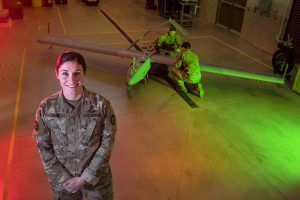 Chief Warrant Officer 2 Kira Tank is a dual-status federal technician, which means she has two jobs in the Idaho Army National Guard. During the week, she is the unmanned aerial systems supervisor for D Company, 116th Brigade Engineer Battalion. During drill weekend, she serves as the company’s operations officer and will become an instructor at the state’s Warrant Officer Candidate School next month.
Chief Warrant Officer 2 Kira Tank is a dual-status federal technician, which means she has two jobs in the Idaho Army National Guard. During the week, she is the unmanned aerial systems supervisor for D Company, 116th Brigade Engineer Battalion. During drill weekend, she serves as the company’s operations officer and will become an instructor at the state’s Warrant Officer Candidate School next month.
“I want to give back,” she said of her new position. “I’ve had a lot of excellent mentors and I think I can do that for other individuals and shape the future of the warrant officer cohort.”
Tank has served in the Idaho Army National Guard for the past 13 years. She began her career as an UAV operator before becoming a maintainer. She deployed with the 116th Cavalry Brigade Combat Team in 2010 in support of Operation New Dawn.
Upon returning from the deployment, she met then Chief Warrant Officer 3 George Tomlinson, who was assigned as the UAS platoon leader. She said she didn’t know much about warrant officers then, but Tomlinson mentored her and Jacob Stavenau and developed them professionally, which led to both Soldiers becoming warrant officers. Tomlinson now serves as the state command chief warrant officer.
As an enlisted member, Tank flew more than 350 UAV missions and reached the rank of staff sergeant before becoming a warrant officer.
“I love being able to bridge the gap between officers and the NCO corps,” she said. “Warrant officers are a very trusted profession. We’re subject matter experts. Officers rotate positions often and they lean heavily on us. They have to be able to trust us to give them the best advice.”
Tank said she joined the Idaho Army National Guard because she wasn’t sure what she wanted to do with her life, but she felt like the military was something she’d be good at. She said she’s made it a career because she really enjoys the comradery she’s found.
As the UAS supervisor, she oversees a team of eight Soldiers and coordinates missions for the company’s Shadow.
“We just have really great hard-working people who are held to a higher standard than their rank,” she said. “They have a lot of the same training and qualifications pilots do.”
She’ll take the lessons she’s learned from the past 13 years to her new position and use them to develop future leaders.
“Being a leader and a mentor is super important to me,” Tank said. “I’ll be able to play a key part in a pivotal point in someone’s career and be someone they can reach back to if they have questions.”
2nd Lt. Elizabeth Horan
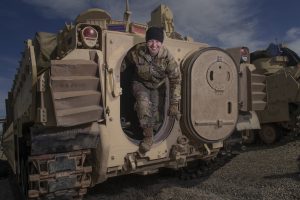 2nd Lt. Elizabeth Horan is a platoon leader for A Company, 116th Brigade Engineer Battalion. As a platoon leader, she leads three dozen 12B combat engineer Soldiers on the battlefield.
2nd Lt. Elizabeth Horan is a platoon leader for A Company, 116th Brigade Engineer Battalion. As a platoon leader, she leads three dozen 12B combat engineer Soldiers on the battlefield.
She joined the Idaho Army National Guard in 2017 as a 15D aircraft powertrain repairer and then earned her commission through BYU-Idaho’s ROTC program in 2020.
“I wanted to serve and to know that I contributed a little bit,” she said. “Plus, it’s fun.”
As a platoon leader, Horan said her job is making sure the platoon’s equipment is taken care of and that her Soldiers’ needs are met, in addition to making critical leadership decisions.
Combat engineers work to provide the maneuver commander with mobility, counter-mobility and survivability support, including detecting and clearing minefields and placing and detonating explosives. A Company uses Bradley Fighting Vehicles to provide engineer support to the 116th Cavalry Brigade Combat Team’s three combined arms battalions.
Horan said she enjoys getting to work with a Bradley crew and training with demolitions. As one of the Army’s junior officers, she relies on her platoon’s NCOs to help mentor her as she gains relevant experience in her career field.
“There’s a wealth of knowledge there,” she said. “A lot of those guys have been there for years and they are so willing to share what they know. It makes it fun to spend time with them on the Bradley and just do different things.”
As a platoon leader, she enjoys working with her Soldiers before she’ll take on additional administrative duties as she moves up in rank.
“Be willing to get dirty, get in and work hard next to your Soldiers,” she said. “Don’t try to excuse yourself from anything.”
1st Lt. Jessica Pauley
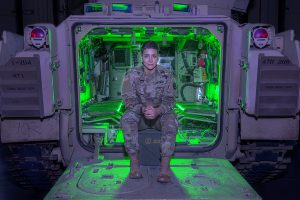 1st Lt. Jessica Pauley is thankful for the females who served before her.
1st Lt. Jessica Pauley is thankful for the females who served before her.
“They paved the way and without them, we wouldn’t be here,” she said.
As the first female infantry officer in the Idaho Army National Guard, Pauley helped paved the way for future female infantry Soldiers to serve in the 2-116th Combined Arms Battalion, but it’s a position she probably wouldn’t have sought out if she hadn’t been encouraged to do so by Sgt. 1st Class Melanie Galletti.
Galletti was the state’s first enlisted female Soldier to become 11B infantry qualified in April 2017. As part of the Army’s initiative to integrate females into combat arms positions, units were required to have a branch qualified female officer and a noncommissioned officer in place before new female recruits could be assigned to the unit.
Pauley knew that by becoming an infantry officer, along with Gelletti, she would pave the way for females to serve in the unit. Since then, several females have served in the state’s only infantry company, but Pauley is currently the only female assigned to the unit.
She’s a platoon leader for C Company, 2-116th Combined Arms Battalion. She oversees four Bradley Fighting Vehicle crews, including her own, and three squads of dismounted infantry Soldiers.
“It’s exactly the stuff people generally join the Army to do,” she said. “We shoot, we do squad and platoon exercises and there’s lots of hands-on training, including demolitions.”
Pauley said the hours are long, but the job is fun. She trains yearlong to be able to meet the physical demands of the job.
“It’s part of my job to be as physically fit as I can be,” she said. “If it comes down to it, Soldiers expect that from me and I expect that from them. Just like I’d expect any of my Soldiers to be able to pull a fully kitted Soldier out of a Bradley Fighting Vehicle while under fire. It’s dangerous if they can’t do it. It’s dangerous if I can’t do it as well.”
Pauley enlisted into the Idaho Army National Guard on her 23rd birthday in 2014. She served as a public affairs specialist before enrolling into the Boise State University ROTC program for her final two years of college. She said getting school paid for and getting paid to go to school seemed like a really good idea.
“It’s a good opportunity for everyone,” Pauley said. “It’s a relatively small commitment and you get the benefits of giving back to your country.”
Pauley has spent most of her career as a part-time Soldier and is looking forward to deploying with the 2-116th Combined Arms Battalion later this year so that she can spend additional time with her platoon.
“I’m excited for the opportunity to get some quality time with my platoon and train,” she said. “When we only see our Soldiers one weekend a month and a few weeks in the summer, there’s only a certain level of proficiency you can hit with that amount of time. We will have the chance to train every day and set some things in stone for Charlie Company that will last longer than our time in the unit.”
Pauley earned her commission in 2018 and attended the US Army’s Infantry Basic Officer Leaders Course in June 2019.
“The entire experience is a learning experience from the moment you swear in,” she said. “You’re faced with challenging situations, and you have to learn as much as you can from each one.”
As she’s grown throughout her time in the Army National Guard, she’s also thankful for those who have mentored her along the way.
“The commanders and first sergeants I’ve had the honor and privilege of serving with have taught me so much and they care so much about Soldiers,” she said. “It’s really inspirational.”
Capt. Haily Barley
 Capt. Haily Barley serves as the commander of Headquarters and Headquarters Company, 2-116th Combined Arms Battalion. She initially commissioned as a signal officer after graduating from the University of Idaho’s ROTC program but rebranched as an armor officer to be closer to the fight on the ground.
Capt. Haily Barley serves as the commander of Headquarters and Headquarters Company, 2-116th Combined Arms Battalion. She initially commissioned as a signal officer after graduating from the University of Idaho’s ROTC program but rebranched as an armor officer to be closer to the fight on the ground.
“I loved the signal community,” she said. “But at the end of the day, I’m just more comfortable and confident in this role, especially with my civilian career. I love it. You’re fighting the fight and have to make decisions more quickly.”
Barley served as a platoon leader and executive officer in the battalion before assuming command of its headquarters unit. As the commander, she is responsible for more than 180 Soldiers and ensures the battalion’s scouts, mortars, snipers, medics and staff are ready to execute their missions when called upon.
“The biggest part is just taking care of your Soldiers, wholeheartedly and leading from the front,” Barley said. “If they are not taken care of, then you don’t have a fight.”
The battalion is scheduled to deploy later this summer.
“I’m excited, but it’s bittersweet,” she said. “Now that I have kids, it’s a little rough, but it’s pretty much the reason you join.”
In addition to serving in the Idaho Army National Guard, Barley is a patrol deputy for the Canyon County Sheriff’s Office.
“Don’t be afraid to make decisions,” Barley said. “Someone might think you’re being bossy or bitchy, but you’re just trying to get your job done. Don’t be afraid to take the reins and learn or fail.”
Maj. Kristin Daigle
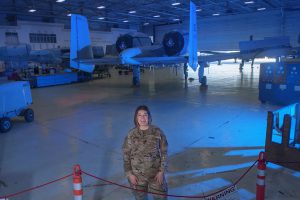 Maj. Kristin Daigle enlisted into the Idaho Air National Guard in 2004 to help pay for college.
Maj. Kristin Daigle enlisted into the Idaho Air National Guard in 2004 to help pay for college.
She attended college at Boise State University without having to take out any student loans and found full time employment within the 124th Fighter Wing shortly after graduation. With her degree, she was also able to commission as an intelligence officer.
“I always wanted to be an officer,” she said. “The timing seemed right.”
Daigle was hired to be an instructor for the wing’s Intelligence Formal Training Unit after spending seven years as an enlisted intelligence analyst. She also worked as the wing’s sexual assault response coordinator and as the executive officer for the Idaho Air National Guard.
Today, she’s the commander of the 124th Fighter Wing’s Maintenance Operations Flight, a position she sought for increased leadership responsibilities.
“Best decision I ever made,” she said. “I love being in maintenance!”
The flight is responsible for the long-range management of the wing’s A-10 Thunderbolt II aircraft and manages aircraft maintenance to meet operational requirements for the 190th Fighter Squadron.
“There are different challenges presented every day,” she said. “There’s always something breaking and you have to figure out how to fix it and still meet the wing’s flying schedule.”
The flight consists of five shops and more than 20 Airmen. Daigle has been in command of the flight since 2019.
“It’s given me an appreciation for everyone’s different perspectives that they bring to the job and I try to balance the mission requirements with making sure the people are taking care of,” she said.
Lt. Col. Christina Taylor
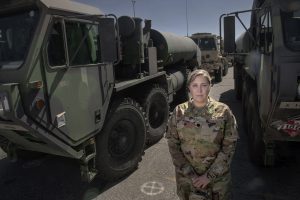 Lt. Col. Christina Taylor joined the University of Idaho Army ROTC program to help pay for college. She chose to commission into the Idaho Army National Guard after graduating so she could have a hand in deciding her future.
Lt. Col. Christina Taylor joined the University of Idaho Army ROTC program to help pay for college. She chose to commission into the Idaho Army National Guard after graduating so she could have a hand in deciding her future.
“I didn’t want the Army to choose for me,” she said. “I wanted to create my own path.”
By serving in the National Guard’s Simultaneous Membership Program, she was able to drill with an Idaho Army National Guard unit while still in college and identify a position for her to serve in after commissioning. Had she chosen to serve in the active Army, the Army would have selected her assignment and duty location.
Taylor drilled with C Company, 145th Brigade Support Battalion, 116th Cavalry Brigade Combat Team and remained with the unit after she commissioned in 2002. It began a path that has led to multiple command positions for Taylor since 2015.
In 2015, Taylor led the Mission Training Complex – Gowen Field. After a short break, she commanded C Company, 145th BSB for most of 2017. She then took command of the Idaho National Guard’s 101st Civil Support Team in February 2018 before transitioning out of that position to command the 145th Brigade Support Battalion last year.
As the 145th BSB commander, Taylor is the 116th Cavalry Brigade Combat Team’s senior logistician and is responsible for ensuring the unit’s maneuver commanders can maintain their operational reach for prolonged periods of time by maintaining logistical and sustainment support in the operational environment. The battalion consists of more than 400 Soldiers that comprise a distribution company, a field maintenance company and a medical support company in addition to forward support companies located throughout the state.
Taylor is also the brigade’s highest-ranking female Soldier, a fact she doesn’t pay much attention to.
“Never in my career has it ever been about me being a woman,” she said. “It’s always about being capable to assist the organization. The Guard’s provided a really great career path for me to be able to grow and learn as a leader. That’s why I chose to make it a career.”
Taylor earned her degree in elementary education and worked as a teacher prior to deploying with the 116th CBCT in 2005 in support of Operation Iraqi Freedom III. She started working fulltime for the Idaho National Guard shortly after returning home from deployment when she was hired as the medical operations officer for the 101st Civil Support Team.
“I like how we can directly give back,” she said. “You can show how one person can actually have an impact and give back to our fellow citizens, state and nation.”
Taylor describes leadership as an upside-down triangle, with leaders representing the bottom point, holding up and supporting Soldiers.
“We work to meet their needs,” she said. “With that mindset, we accomplish a lot more.”
Col. Elizabeth Sumner
 Col. Elizabeth Sumner is the highest-ranking female in the Idaho National Guard. She leads more than 340 Airmen as the 124th Mission Support Group commander.
Col. Elizabeth Sumner is the highest-ranking female in the Idaho National Guard. She leads more than 340 Airmen as the 124th Mission Support Group commander.
The 124th Mission Support Group consists of four squadrons and one flight and provides a wide range of support for the 124th Fighter Wing. The group includes facilities, communications, security forces, logistics, civil engineering, contracting and force support.
“People are my mission,” she said. “I focus on getting them the resources they need to be successful because they are the ones who accomplish the Air Force’s mission.”
Sumner began her career in the United States Air Force before transferring to the Idaho Air National Guard in 2008 to find a good balance between having a military career, a civilian career and a spouse who also served in the Air Force.
“I thought it was the perfect marriage of things I liked to do,” she said. “I drilled on the weekends and I worked for an engineer company in Boise during the week.”
Sumner served in the Alaska National Guard and the Florida National Guard as her husband received new assignments before transferring back to the Idaho Air National Guard again in 2014 when he retired.
“I always wanted to serve,” she said. “I like being part of something bigger than myself and I like the discipline that comes with serving in the military.”
Sumner started her military career as an intelligence officer and later became an instructor at the wing’s Intelligence Formal Training Unit. She realized that the same qualities that would make her a good instructor to her students would also make her a good leader to her Airmen: be humble, credible and approachable.
“I think what we do in the Guard is such an incredible balance to the active duty,” Sumner said. “It comes from vast different experiences everyone brings. As a leader, it’s important to realize that differences can be a huge strength to an organization and that we should invite those differences of opinion, perspectives and experiences so we can get to the best solutions.”
Idaho National Guard trains together for joint combat rescue missions
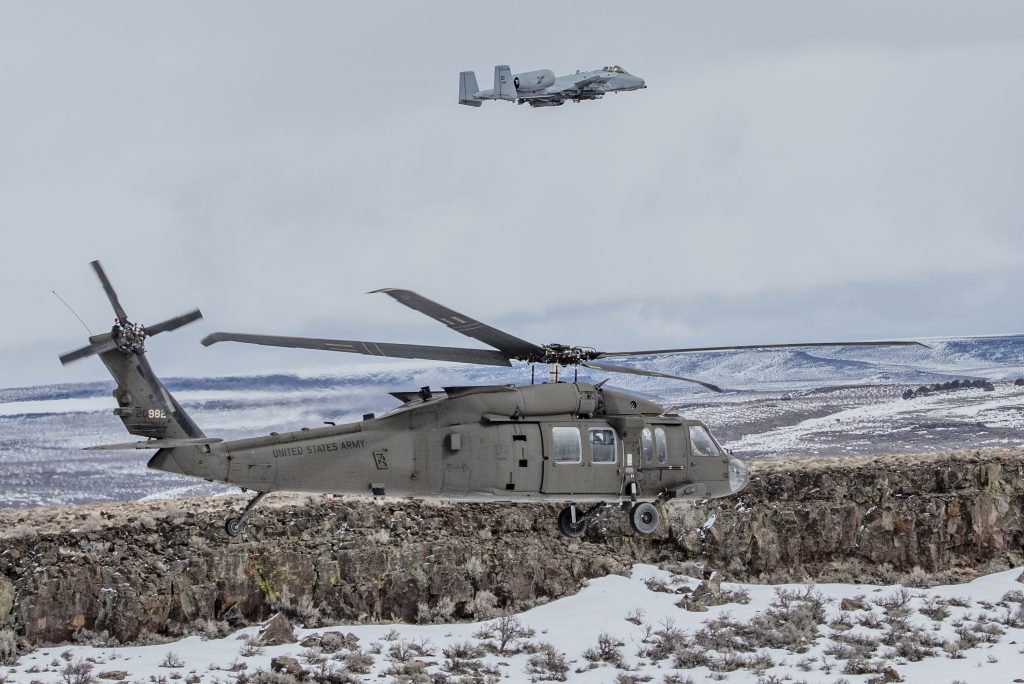
Master Sgt. Becky Vanshur/Idaho Military Division Public Affairs
Idaho Army National Guard and Idaho Air National Guard aviation units conducted combat search and rescue training together March 9 throughout Idaho’s Owyhee Mountains.
“Any opportunity to integrate the Army and Air missions in a joint training capacity is beneficial to both units,” said 1st Lt. Kate Smith, a mission planner for the Idaho Army National Guard’s Army Aviation Support Facility. “Because our missions can overlay in-country and in combat, anytime we have that ability to work together and integrate our systems, the training only helps our operations to be more seamless when it comes to the real-world missions.”
The training rescue missions involved 124th Fighter Wing A-10 Thunderbolt II pilots escorting Idaho Army National Guard Aviation Group’s UH-60 Black Hawk pilots along the safest route of a simulated combat zone and advising them of any possible enemy threats. The Idaho Air National Guard’s 266th Range Squadron provided simulated threats to pilots from both forces using its Joint Threat Emitter equipment.
Airframes such as the UH-60 Black Hawk require A-10 Thunderbolts or other fighter jets to escort them in CSAR missions during combat operations because Black Hawks are a transport aircraft designed to extract or recover personnel and do not have the capacity to carry heavy weapons.
After the A-10’s ensure the safety of the extraction point, the Black Hawks can approach the extraction site and utilize their hoist rescue equipment or land on the ground to recover personnel. The A-10s continue to provide air-to-ground support while circling the area. After the personnel have been recovered, the A-10s escort the helicopters until they are out of enemy contact.
“Having the Idaho Army National Guard assets readily available to allow realistic training scenarios for our fighter pilots is a huge benefit that we absolutely have to capitalize on when and where we can,” said Col. Chad Kornberg, 124th Fighter Wing commander. “The combination of airspace, threat simulation and air assets that we have in Idaho enable some of the most premier training opportunities in the nation.”
Because the Idaho National Guard’s aviation assets are co-located on Gowen Field, units are routinely able to conduct training together to increases its interoperability working with other services while conducting enhanced training that may not otherwise be available.
“Although the Idaho Army and Air National Guard have already been successfully working together for years, it is a strategic goal to amp up our joint training. We want to integrate with our assets as much as we possibly can going forward,” said Smith.
The Nez Perce Tribe and Idaho National Guard work together during COVID-19
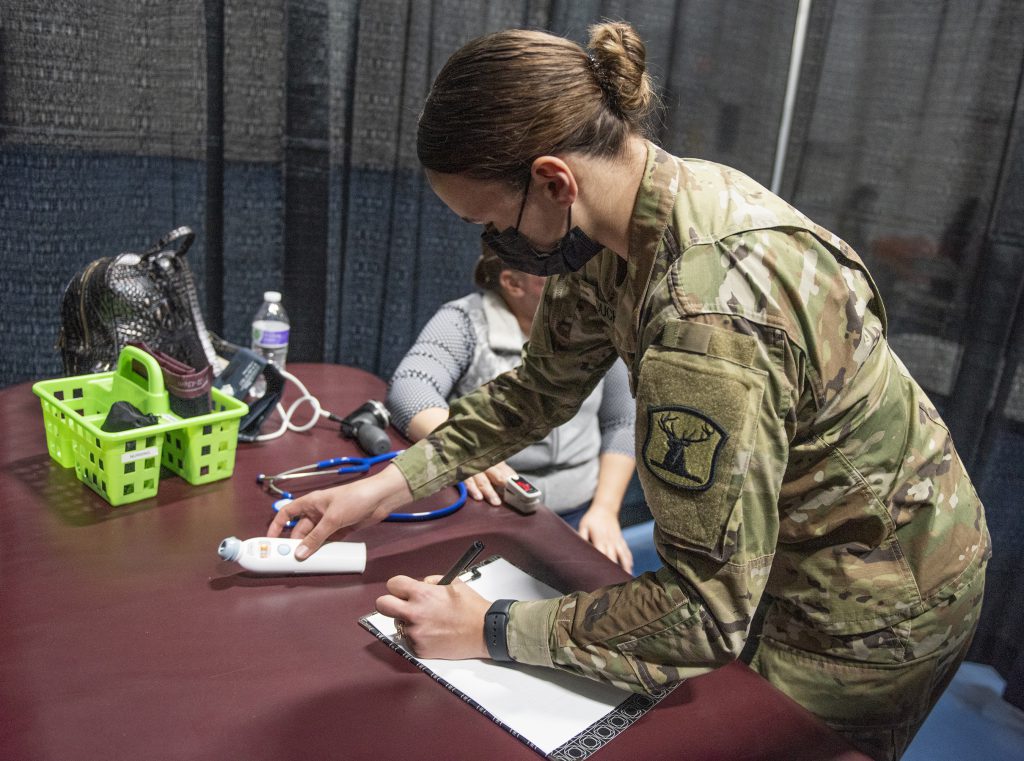
Master Sgt. Becky Vanshur/Idaho Military Division Public Affairs
Nez Perce Reservation, IDAHO – Idaho National Guard and Nez Perce dental personnel teamed up Nov. 10 – 13 as part of a larger effort to recover from the summer’s surge of COVID-19 cases plaguing northern Idaho.
The Nez Perce Tribe and the Idaho National Guard are working together through a program known as Innovative Readiness Training to help the Nez Perce community’s healthcare system recover after becoming backlogged during a community-wide shut down earlier this year. The dental visit was part of a larger medical effort taking place between the tribe and the Idaho National Guard.
“Idaho National Guard members are driven by a sense of purpose,” said Maj. Gen. Michael Garshak, the adjutant general of Idaho. “IRT collaboration like this not only enables us to sharpen our military skills, but it also provides great opportunities to make positive impacts to the communities of Idaho and a difference in the lives of our fellow citizens.”
The Nez Perce tribe submitted a collaborative IRT application earlier this summer to request assistance in addressing their overwhelmed medical staff resulting from the second wave of COVID-19 cases. The Idaho National Guard responded by sending medical and dental citizen-Soldiers and Airmen performing three missions—a two-part diabetic IRT in June and October, a medical IRT in August and most recently the dental IRT in November, which resulted in dental screenings of nearly 250 Nez Perce school-aged children. Activities also included helping local clinics complete high school sports physicals and preschool Head Start program physical exams before the start of sports season and the school year.
“Working with their local health care personnel helps us build relationships with the tribes while training our Idaho National Guard medical personnel,” said Lt. Col. Tina Williams, an occupational health nurse for the Idaho Army National Guard. “Our mission is to help the Nez Perce community catch up on a backlog of patients while providing Guardsmen relevant training and a unique experience by seeing both adults and children at the Nez Perce clinics.”
Idaho National Guard personnel also assisted tribe clinicians at two large COVID-19 vaccination clinics located at Lapwai and Kamiah.
“The National Guard has helped us with several projects throughout the pandemic,” said Roxie Kim Hartwig, M.D. at Nimiipuu Health with the Nez Perce Tribe. “One of our mass vaccination events would have been impossible without the Idaho National Guard. The purpose of the diabetic IRT is to help us catch up with care that has been delayed due to the pandemic and provides training for the National Guard medical staff to gain some practical knowledge about our medical application.”
Williams said the Nez Perce staff was thankful for the Idaho National Guard’s timely assistance with the diabetic clinics, sports physicals and dental exams as the tribe is beginning to see another increase in COVID-19 screenings.
COVID response prompts Idaho National Guard to establish first dual-status commander
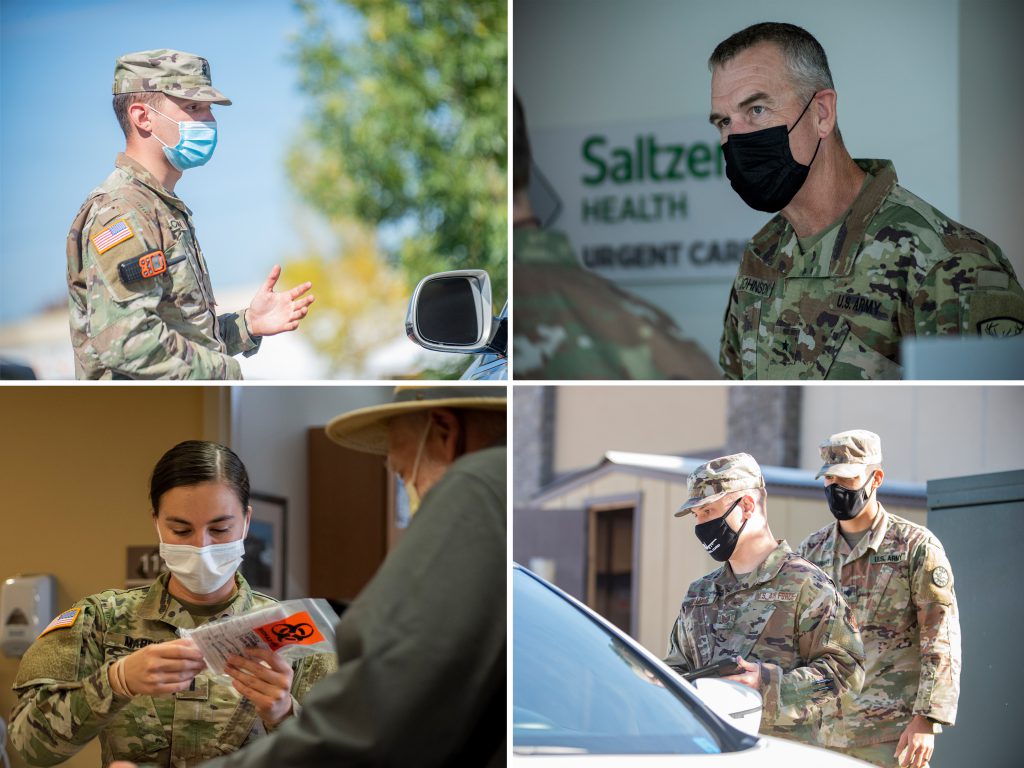
Idaho Military Division Public Affairs/Crystal Farris
In September, after a second wave of COVID-19 cases spread across Idaho, Gov. Brad Little authorized the mobilization of up to 150 Idaho National Guard Soldiers and Airmen. He also requested additional federal support as a last-ditch effort to avoid activating a statewide crisis standards of care—a first in Idaho’s history.
On Sept. 7, at the recommendation of Gov. Little and the Adjutant General of Idaho Maj. Gen. Michael Garshak, U.S. Northern Command appointed Brig. Gen. Russ Johnson, Idaho National Guard director of joint staff, as the state’s first-ever dual-status commander. That same day, Idaho Guardsmen and federal active duty military personnel began reporting to hospitals, clinics and other medical facilities across the state in support of overwhelmed medical staff.
“Joint Task Force – Idaho is helping free up civilian medical staff allowing them to focus on providing medical care during the ongoing surge in COVID-19 cases,” said Johnson. “Collectively, our Title 32 Idaho National Guardsmen and Title 10 active duty personnel are employed in direct support of our healthcare sector, making a difference in the lives of Idaho citizens every day.”
Currently, Idaho National Guardsmen are serving at nearly two-dozen healthcare facilities across the state performing non-clinical duties including medical screenings, testing collection, logistics assistance and other administrative tasks.
Idaho National Guard Col. Britt Vanshur, chief of the joint staff, said the Idaho National Guard provides support in administrative functions rather than playing a clinical role, since the majority of its medical professionals are part-time Guardsmen already working full time at hospitals, clinics and healthcare facilities.
“It would be imprudent to pull our Idaho Guard medical personnel from their civilian capacities at these healthcare facilities just to activate and send them back in uniform to perform these same tasks,” said Vanshur. “They’re already making a positive impact on the health districts in their civilian capacity.”
This activation marks the second time since the beginning of the pandemic that Idaho National Guardsmen have deployed in response to COVID-19. In March 2020, the Idaho National Guard began mobilizing more than 400 citizen-Soldiers and Airmen as part of the organization’s first COVID-19 relief effort, named Task Force Agile Response.
During this second wave, while record numbers of COVID-19 cases overwhelmed northern Idaho, Kootenai Health requested assistance through the Idaho Office of Emergency Management as the hospital’s capability reached its limits, forcing it to implement emergency standards of care.
In response to this request, the Department of Defense, through U.S. Northern Command, allocated a U.S. Army medical response team. The 23-person MRT is augmenting Kootenai Health by providing doctors, nurses and respiratory therapists from various commands and locations, including Fort Carson, Colorado and Joint Base Lewis-McChord, Washington.
This is the first time in Idaho history that Title 32 and Title 10 personnel have mobilized under one joint task force creating the demand for a dual-status commander to effectively coordinate response efforts between both forces.
“Dual-status command effectively streamlines National Guard and active component efforts under a single commander in support of state and federal civil authorities,” said Johnson. “It ensures we all pull in the same direction to meet the needs—current and emerging—of the governor and his emergency management leadership.”
Idaho is one of several states to recently activate a dual-status commander for COVID-19 response. Other states include Alabama, Mississippi, Louisiana and Tennessee.
Members of Joint Task Force – Idaho have collectively worked thousands of hours since September, while providing care to COVID-19 patients and much-needed relief to overworked healthcare facility staffs.
“Idaho’s joint task force has been highly successful on many fronts,” said Johnson. “Our Guardsmen and active duty counterparts have put their personal lives on hold to come together and answer the call of fellow citizens during this historic pandemic.”
Idaho National Guard sends first wildland firefighting crew to northern Idaho
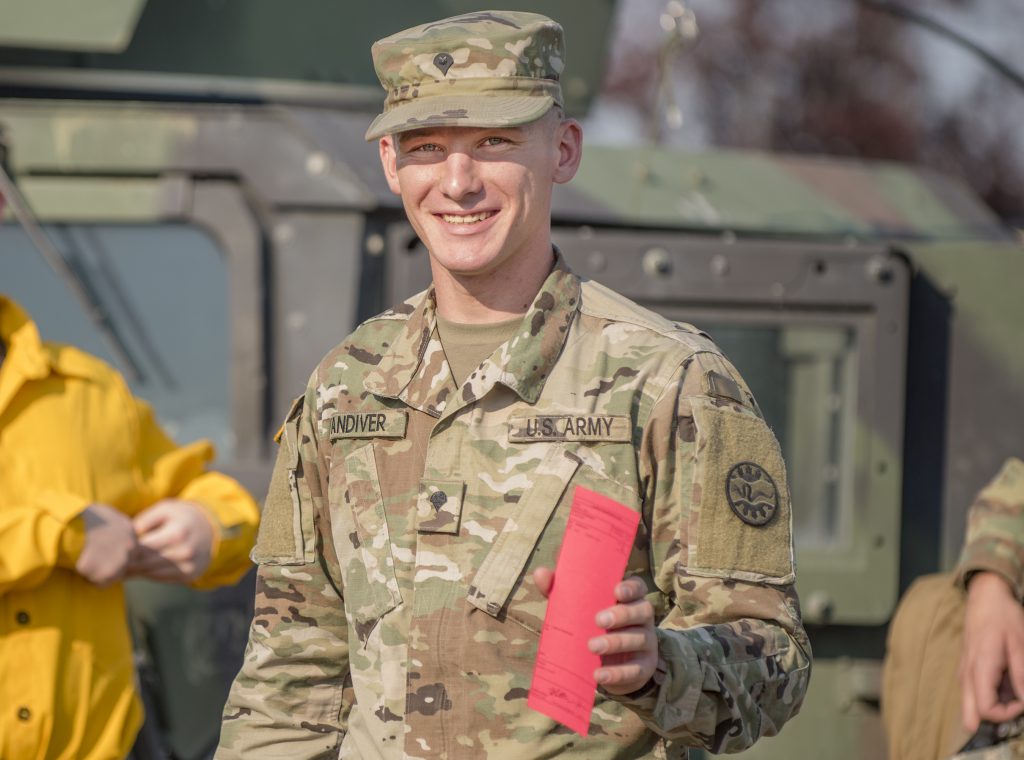
Idaho Military Division Public Affairs/Master Sgt. Becky Vanshur
Idaho National Guard Soldiers and Airmen made organizational history by sending wildland Firefighter Type 2 Red Card certified Guardsmen to northern Idaho to fight fires for the first time. The newly assigned crewmembers of the Task Force Timber Shield left Boise Aug. 4 to assist the Idaho Department of Lands’ mission of containing more than 15 significant wildland fires currently burning in Idaho.
It is the first time the IDL requested Idaho Gov. Brad Little to issue an emergency declaration for making Idaho National Guard resources available to assist fighting against fires on the ground. For some Guardsmen, the volunteer notice came early in July and they immediately began training to earn their FFT2 Incident Qualification Cards, commonly known as a Red Card certification.
“I made sure my name was on that list when I heard the call for volunteers,” said 2nd Lt. Travis Stice. “It will be hard, physical labor, which I am excited for. I told my son that I was going to leave to go fight fires and he said, ‘but you are in the Army, you’re not a firefighter,’ and I said, ‘We do everything, buddy.’”
Stice is one of 72 Guardsmen who has earned his Red Card and more personnel are currently completing the training in anticipation of additional missions. He joined the Idaho National Guard four years ago and this is his first State Active Duty mission as a Guardsman.
“I am very excited that this is a state mission,” Stice said. “It’s the reason I signed up for the Idaho National Guard, to help the citizens of Idaho, along with serving my country. I just love my fellow Idahoans. I called my employer with one day’s notice and they said ‘awesome, just come back safe and we’ll work everything out when you come back.’ They were very supportive even with the short notice.”
The additional training for more Red Card certified Guardsmen stemmed after the governor issued the emergency declaration July 9 to mobilize Idaho National Guard fire line FFT2 qualified personnel to work on active wildfire efforts on the 6.2 million acres of land across mostly northern Idaho where IDL provides fire protection.
The FFT2 crew consists of sixteen fully trained Idaho Guardsmen. The IDL provided one crew boss and two squad bosses to complete a full nineteen-man crew.
“We are currently training more Soldiers and Airmen as they volunteer for this mission in the hopes of building a large capacity consisting of several hand crews,” said Lt. Col. Tony Vincelli, commander of Task Force Timber Shield. “This is the kind of mission that makes serving in the National Guard so unique and rewarding. I hope Soldiers and Airmen see how rewarding this mission is and truly understand the impact they could have.”
The Guardsmen were issued firefighting personal protective equipment, fire-resistant clothing, hand tools and sleeping accommodations just prior to leaving.
“The boots on the ground, physical labor of this kind of work is different than anything I have ever done in my career,” said Maj. Robin Kiska, from the 224th Cyber Operations Squadron, Idaho Air National Guard. “It’s like an extreme hiking adventure in extreme conditions. It will be hard work but a welcomed challenge.”
The governor’s emergency declaration also authorized other personnel to support fire logistic activities and make National Guard aircraft resources available.
Currently, the Idaho National Guard has two UH-60 Black Hawk helicopters and pilots, crew chiefs, refueling crew and essential maintenance personnel assisting with aerial firefighting by delivering water using large capacity “Bambi Buckets,” or helicopter buckets, suspended from helicopter cables. The UH-60 Black Hawk crews have been assisting Idaho’s mission this fire season since July 13 and have dropped more than 187,096 gallons of water on several fires.
Additionally, a request for help at the Idaho Fire Cache warehouse in Coeur d’Alene sent eight Guardsmen on July 21 to provide logistical and operational support of daily refurbishment operation to include palletizing orders, building kits, cleaning, repackaging firefighting hoses and pulling stock of supplies and equipment for state and federal wildland firefighters.
The IDL, the Idaho Office of Emergency Management and the Idaho National Guard developed a partnership a few years ago through a Joint Powers Agreement, defining the process involved in interagency coordination, support, training and planning during times of emergency involving mutual aid of wildland fire relief within Idaho.
“Today marked yet another milestone in the proud history of the Idaho National Guard as wildland firefighter ground crews mobilized and deployed to support the growing wildland fire threats across our state,” said Brig. Gen. Russ Johnson, director of the Idaho National Guard Joint Staff. “Our National Guard service members – and their families – have again answered the call to support the citizens of Idaho during this volatile fire season.”
Currently, around the country more than 770 National Guard Soldiers and Airmen from eight states are assisting with fighting wildland fires. Four UH-60 Black Hawks, two CH-47 Chinooks and one UH-72 Lakota are supporting aviation wildfire operations across the nation. Four C-130 crews are in California, Nevada and Wyoming equipped with Modular Airborne Fire Fighting Systems. To date, National Guard MAFFS crews have made 357 drops and flown 366 sorties in support of the fires across the United States. The National Interagency Fire Center reports over 38,200 fires have burned a total of 3.2 million acres across 14 states.
 Official Government Website
Official Government Website